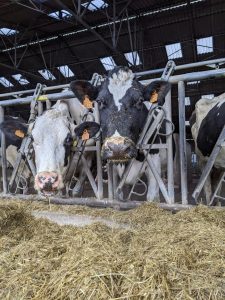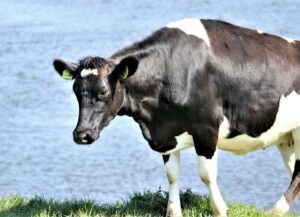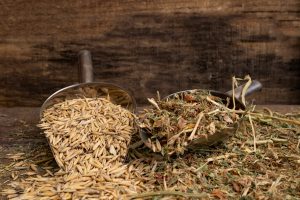Álvaro García
How many times have you heard the debate about feeding hay to young calves? Whether discussed at farm meetings, during veterinary visits, or in extension publications, the question keeps coming up—often surrounded by strong opinions rather than clear data. Some believe that young calves are not physiologically ready to handle forage, while others argue that introducing roughage early supports rumen development.
A recent review of multiple research studies (Jianxin et al. 2025) provides a thorough evaluation of how forage feeding affects dry matter intake (DMI), average daily gain (ADG), body weight (BW), and overall performance during both pre- and postweaning stages. One key finding was that forage supplementation increased total DMI, particularly when offered free-choice. The effect was more pronounced after weaning and is likely due to greater rumen capacity and more mature appetite regulation.
Forage exposure also contributed to better postweaning weight gains, suggesting that early fiber intake helps prepare the digestive system for life without milk (García and Erickson 2001). However, feed efficiency—measured as weight gain per unit of intake—declined slightly. This modest reduction likely reflects the energy cost of fermenting fibrous material, which can reduce how efficiently feed is converted into body mass.
Several factors influenced how calves responded to forage, including the source of forage, type of starter feed, and amount of milk offered. Calves receiving 1 to 1.5 gallons of milk per day showed the most consistent improvements in DMI and growth when forage was included. This supports current recommendations to limit milk volumes to encourage earlier solid feed intake and foster rumen development.
Starter feed form made a noticeable difference. Calves fed ground starter consumed more and gained more weight than those fed pelleted or textured feeds. Ground starter likely mixes better with forage in the rumen, enhancing both palatability and digestion. Among the forages evaluated, oat hay consistently delivered the best outcomes in terms of intake and growth. Its balance of digestibility and palatability may give it an edge over alfalfa or straw. While alfalfa offers more protein, its coarse fiber and slower degradation rate can reduce its attractiveness and intake in some calves.
Structural growth
Hay supplementation had noticeable effects on the physical development of calves, especially after weaning. Calves fed forage showed greater body length and barrel size, which are commonly used indicators of internal growth and developmental maturity. These changes likely reflect increased rumen fill and organ development rather than accelerated skeletal growth.
In contrast, no significant differences were observed in withers height, hip height, or heart girth, suggesting that forage feeding does not influence overall frame size within the same timeframe. The expanded barrel likely results from increased gut capacity and rumen volume rather than bone growth—an effect consistent with previous findings showing that fibrous feeds can cause abdominal distention without affecting skeletal dimensions.
The type of forage and feeding method also shaped these outcomes. Oat hay and straw, particularly when offered free-choice instead of in a total mixed ration (TMR), led to greater body length. Calves receiving ground starter alongside forage achieved better structural development than those fed pelleted or textured feeds. This supports the idea that both forage particle length and starter texture influence how calves process and benefit from fiber. Chewing longer forage particles and ground feed may stimulate ruminal muscle development and tissue growth, echoing earlier guidance by García and Erickson (2001).
Rumen fermentation
Forage feeding also induced substantial changes in rumen fermentation profiles. Volatile fatty acid (VFA) composition shifted toward increased acetate production and higher acetate-to-propionate ratios, indicating a greater reliance on fiber fermentation. The rise in acetate suggests enhanced fiber digesting activity, reflecting the maturing rumen’s capacity to degrade it.
Interestingly, total VFA concentrations declined with forage inclusion, particularly postweaning. This decrease could arise from faster absorption of VFAs across a more developed rumen epithelium, rather than from lower fermentation rates. The net result is an improved rumen environment, less acidic and more stable, conducive to the growth of beneficial microbiota.
Forage-fed calves exhibited lower rumen propionate and butyrate compared to controls. Since propionate is predominantly produced through starch fermentation, its decline reflects a shift in fermentation patterns due to higher forage and lower concentrate intake. Butyrate, essential for rumen epithelial growth, also decreased slightly postweaning. Although this might seem detrimental, the overall improvement in rumen conditions may counterbalance the lower butyrate concentrations.
Forage form, delivery method, and starter type influenced fermentation outcomes. For example, calves receiving pelleted starter experienced more drastic reductions in propionate and total VFA, suggesting a mismatch between rapidly fermentable starch and fiber intake. Ground starter, by contrast, offered more balanced fermentation and better synergy with forage, reinforcing the idea that physical characteristics of feed are as important as nutrient composition.
Milk feeding amounts also played a role, with moderate milk intake (1 to 1.5 gallons/day) supporting more stable fermentation patterns when paired with forage. Higher milk volumes (more than 1.5 gallons/day) may suppress solid feed intake, delay rumen development, and diminish the benefits of forage inclusion.
Nutrient digestibility
Contrary to concerns that forage might compromise nutrient digestibility in calves, this meta-analysis found no significant effect of forage on postweaning digestibility measures, including dry matter digestibility, organic matter digestibility, crude protein digestibility, and neutral detergent fiber digestibility. This suggests that once the rumen is sufficiently developed, calves can handle moderate forage intake without sacrificing nutrient absorption.
Some studies had previously indicated that high-fiber diets might reduce digestibility, particularly before weaning. However, the lack of significance in this analysis suggests that moderate inclusion of forage, particularly alfalfa or oats at controlled amounts, does not impair digestive efficiency in older calves.
Optimal forage inclusion rates
Determining the ideal amount of forage inclusion is crucial for maximizing benefits while avoiding potential drawbacks like reduced energy density. The analysis showed that preweaning dry matter intake increased as more forage was added to the diet, but only up to a point. The highest intake was seen when forage made up around 12% of the diet’s dry matter. At this level, the amount of fiber seems just right to stimulate rumen development without making the diet too bulky or difficult for the young calf to digest. When broken down by forage type, optimal inclusion was approximately 9% for oats and straw. Interestingly, alfalfa showed potential for higher inclusion (up to 19%), although this estimate requires further validation. The differences in optimal levels may reflect differences in fiber digestibility, protein content, and palatability among forage types. These findings support recommendations to limit forage to no more than 10–15% of the diet in early life stages, adjusting based on forage quality and feeding strategy.
In summary, this meta-analysis confirms that including forage in calf diets, especially before weaning, can enhance intake, promote growth, support rumen development, and improve internal body condition. The benefits were clearest when hay was offered free-choice, paired with ground starter, and provided alongside moderate milk volumes. Among the hay types evaluated, oat hay showed the most consistent advantages. Optimal performance was seen when forage made up around 12% of the diet’s dry matter, though the best level may vary slightly by forage type and feeding conditions.
© 2025 Dellait Knowledge Center. All Rights Reserved.









